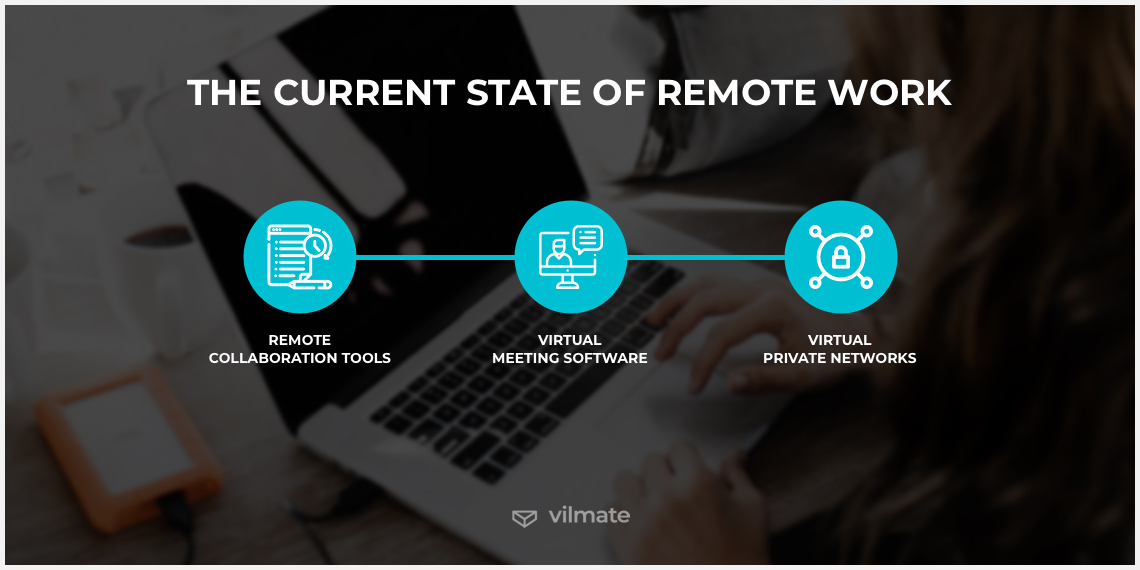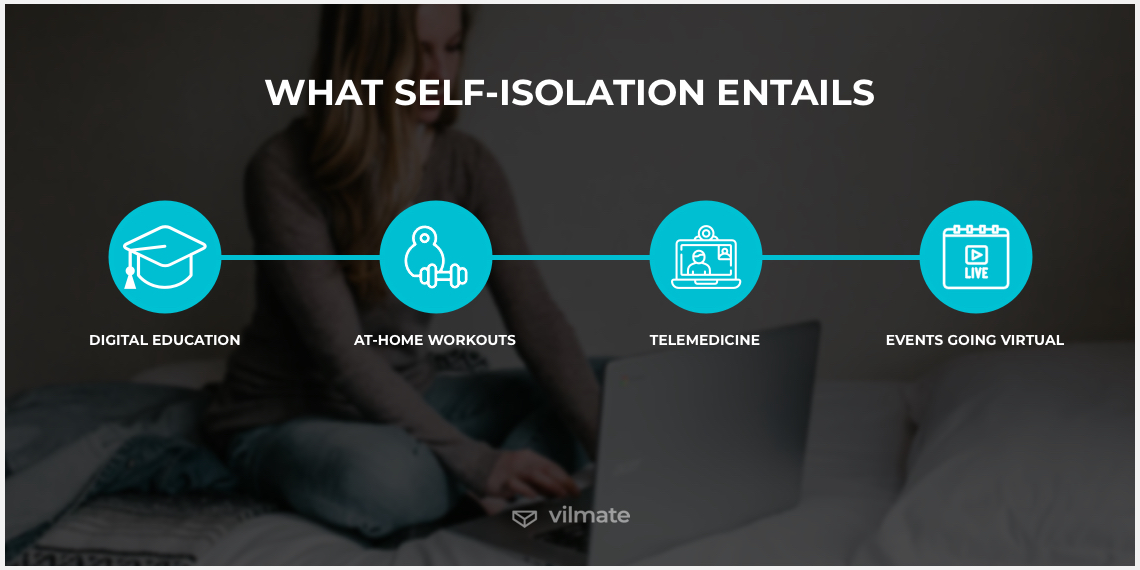Up until recently, remote working has been discussed in conjunction with the possibility to travel more freely, while cutting painful commutes and reducing stress levels. Working from home was a privilege available in specific cases under a special arrangement with the management. However, as digital communication was evolving, remote employment was more and more becoming a reality for many individuals. This transformation was gradual. But the necessity is the mother of invention. The outbreak of coronavirus (COVID-19) persistently prompted many around the world to not only rethink their daily lives but also digitally transform their places of work.
For some, the reality of remote work has proven to be different from what our dreams and hopes were like. Oftentimes remote working doesn't bring about better results. But it is imperative these days to learn to operate effectively amidst social distancing. The IT sector is exceptionally well-positioned to keep going under the circumstances, setting up remote teams, and discovering the benefits of this type of culture.
The current state of remote work
The recent increase in working from home raised interest in and demand for infrastructure that could provide monitoring and cooperation capabilities for companies. As the coronavirus story unfolds, organizations take measures to provide themselves and their employees with a sufficient level of digital safety and a higher level of comfort when working remotely. Organizations that hadn’t committed enough to invest in teleworking strategies have a unique opportunity now to finally make improvements to the digital employee experience.

The appropriate technology infrastructure can allow working from home, but many companies actually lack it. Remote collaboration tools, virtual meeting software, and virtual private networks (VPNs) give support to enterprises in streamlining their operations and creating a foundation for remote digital access.
Remote collaboration tools - When employees are isolated physically from each other, their day-to-day work should be enabled and supported by appropriate technological solutions. Office chat groups and remote access to critical tools should be at the core of the infrastructure. Tencent’s WeChat Work, Alibaba’s DingTalk, or Slack’s native apps, would make collaboration easier and faster. Moreover, a number of tech companies, including Google (Hangouts Meet), Microsoft (Microsoft Teams), Zoom, LogMeIn, and Cisco (Webex), are rolling out their tools for free for extended trial periods or at lower fees during the coronavirus disease (COVID-19) outbreak.
Virtual meeting software - Remote work relies much on digital communication. Teleconferencing software is helping people around the world adapt to remote work with their resources. As the demand for teleconferencing software is rising, software providers do their best to accommodate this demand. When fears of a recession are on the rise, tech companies that provide virtual meeting software could benefit from office closures. Microsoft, Zoom, Slack, Citrix, and RingCentral have good chances for seeing their stock price grow if they manage to satisfy customer demand. On the other hand, however, not only tech providers but also employees themselves must get used to going to digital meetings, learn to navigate the virtual space as well as prevent communication and cultural break downs.
Virtual private networks - VPN solutions provide secure remote access to business assets and online services. They afford an additional layer of protection by encrypting traffic, creating an encrypted tunnel from the user’s computer to a remote server. The VPN is not only an important link in the remote work chain but generally a preferable tool for an employee to use when working for the company. So now it’s time to develop a VPN usage policy that would explain how an employee can and cannot use a VPN for work.
Therefore, as of today, VPN service providers are experiencing an alarming growth in users. NordVPN has reported its business VPN solution, NordVPN Teams has experienced a 165% growth in new users. Meanwhile, corporate VPNs are experiencing unusual quirks caused by thousands of telecommuting employees. However, these are new challenges to learn from and examples of proper corporate VPN management to look out for.
Is remote work effective?
Now, many employees and their managers happen to be separated for the first time. It raises a big concern about a drop in productivity. Can an employee remain productive when there is no constant supervision? To answer this question, it’s essential to take a snapshot of the remote work environment and see how it differs how it was when employees worked at the office. This allows noticing what distractors stand in the way of great productivity.
Remote working can be effective. The thing is letting things run their course is not an option. First, some of our recommendations for improving communication in agile teams can prove workable in the situation of social distancing. Second, more and more articles are being dedicated to giving advice on how people should cope with the change. High-profile publications by Harvard Business Review, Forbes, the Wall Street Journal, and more are being produced to help teams and their management deal with the challenges of remote working. And to top it all off, statistics prove that high remote workers’ effectiveness is not a myth! Analytics data show the following:
64% of today’s professionals say they could work anywhere and remote work policies are standard (Gartner)
Organizations that promote a choose-your-own-work-style (CYOW) culture will boost the rates of employee retention by over 10%. (Gartner)
Those who work remotely 60% to 80% of the time are most likely to strongly agree that their engagement needs related to development and relationships are being met (Gallup)
54% of office workers say they’d leave their job for one that offers flexible work time. (Gallup)
On average, remote employees work 1.4 more days every month than those who work in an office. (Airtasker)
22% of office employees, compared to 15% of remote employees, claim their boss distracts them from work. (Airtasker)
2 to 3 days of telecommuting a week allow for a balance of concentrative work at home and collaborative work at the office. (Global Workplace Analytics)
An employer can save an average of $11,000 per half-time telecommuter per year. (Global Workplace Analytics)
34% of U.S. employees would accept a pay reduction of up to 5% to work remotely. (Owl Labs)
71% of remote workers say they are happy in their jobs, which is 29% more than in the case with their on-site counterparts (55%.) (Owl Labs)
What self-isolation entails: surprising benefits of being home alone
Despite all the difficulties, remote teams continue to drive businesses and move the economy forward in these difficult times. In many ways, the concept of a remote team is, if not best practice, then at least a model exercised by a significant portion of companies now. Due to the scale at which it is now being adopted, a remote work model has every chance to rapidly mature and become even more advanced. In return, the digital world is pushing the boundaries of technology, transforming the landscape for the better. Presently, it has pretty much to offer to remote workers in terms of education, sport, healthcare, and events, brightening their lives and opening up a world of opportunity.

1. Digital education
Schools and universities started to turn to virtual learning options in an attempt to contain the spread of the coronavirus. While the majority of education organizations admit they were not appropriately set up for such an instant change, remote learning and digital learning environments continue to become more accessible to not only children but also adults around the globe. Online degrees, certificates, and courses had been widely available on numerous platforms, including Coursera, Udemy, Udacity, edX, Open Yale Courses, MIT OpenCourseWare, and many others.
During the COVID-19 pandemic, Coursera announced it would provide universities affected by the outbreak with access to the course catalog free of charge. Odds are this move must be the beginning of a new era. Vendors can now sense the demand for online education. And educational institutions have nothing to do but adjust to this shift. Translating teaching expertise into a different learning modality is challenging but still possible. Many high-quality immersive courses are already available, and more are to be expected.
2. At-home workouts
Working remotely generally means less physical activity. Another hurdle caused by the coronavirus pandemic is the closure of sports clubs. However, it doesn’t imply that one should stop exercising at all. Regular workouts are the best way to build one’s immune system and relieve stress, which is vital today. Thus, it’s time to embrace change to one’s daily routine and take an exercise-at-home approach. These are some of the options to benefit from when practicing social distancing:
- Strength training at home
- Walking or running
- At-home stretching
- Yoga and pilates
- Systematic physical drills
There are multiple ways to stay active and healthy at home. To make self-isolation workouts part of one’s fitness routine, an organized workout plan can be helpful. Mobile apps and YouTube channels are excellent online resources to stay fit at home. Set a goal, create a schedule, choose types of activities you like, and go ahead!
3. Telemedicine
Many of us may still need medical help during social distancing. This raises the question of how to see a doctor when you are supposed to sit at home. The answer is telehealth. Telehealth allows you to discuss your health concerns with your doctor in the comfort of your own home: via video, phone, or text. In a COVID-19 crisis, the immunocompromised or quarantined can benefit from telemedicine to get doctor’s advice. At the same time, the patients who think they have symptoms of coronavirus can ask for help and get it without showing up at the ER and exposing others. There are even services that allow you to do this for free.
In fact, the recent bill for coronavirus funding in the U.S. Congress allows Medicare providers to extend telemedicine services, which means there is potential for telemedicine services to become routine in the future, and not only in the United States.
Telemedicine can also be used to help veterinary patients. Delivering veterinary care during the virus outbreak is possible, but it requires an existing veterinary-client-patient relationship (a vet has previously seen a pet in person.) For example, the American Veterinary Medical Association urges to use telemedicine to protect and monitor the health of veterinary patients and veterinary teams.
4. Events going virtual
Virtual events thrive amid the coronavirus outbreak. The pandemic is causing organizers to cancel or postpone huge events like the Olympics, Mobile World Congress, Google Cloud Next ’20, the Cannes Film Festival, Coachella, and Eurovision. Massively more small- to mid-scale events have already shared the same fate. As a result, the demand for the digital alternative is exploding. Thus, an ever-increasing number of artists are trying to provide free concert experiences for their fans without sacrificing safety. From pop singers hosting virtual concerts daily on Instagram using the hashtag #TogetherAtHome to Met Opera singers to stand-up comics – the entertainment industry is seeking to offset the losses and support those in self-isolation.
While Zoom is primarily used for corporate videoconferencing and group video calls, there are other platforms equipped to accommodate online events. For instance, Collison, the fastest-growing tech conference in North America, turned to virtual this year. Launched as Collison from Home, it got postponed to June 2020 and is going to be held online. In the same way, the Android Makers conference has been modified to take place online. Conference organizers are now compelled to think outside the box, looking for workable options.
Conclusion
People around the world are now adapting to remote work. Some managers are facing remote work for the first time. Some employees find themselves in a position where they’re able to shift their workday to where they’re more productive but still may be feeling stress and anxiety in today’s circumstances. Improving remote work policies and capabilities in organizations and adapting to the new normal is the best course to take. The key is to educate everyone about the ways in which remote work can benefit employees and the organizations and to be proactive in bringing more opportunities for more remote workers.

© 2020, Vilmate LLC




